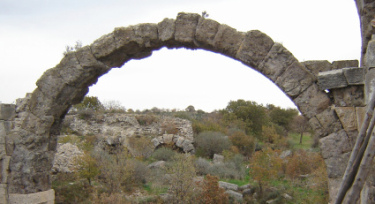The name Troas, as a ancient reference, referred not only to the city itself but also to the surrounding district. As such, Troas eventually expanded to take up an estimated 1,000 acres (400 hectares).
As the chief port of northwest Asia Minor, Troas prospered in Roman times, becoming a Roman "free city" as early as 188 B.C. After the city became 'free' it began to strike a vast quantity of its own coins. In its heyday the city may have had a population of about 100,000.
The Roman Emperor Trajan (reigned 98 to 117 A.D.) built an aqueduct in the Troas area. Remains of an ancient bath and gymnasium complex have also been discovered in the Troas area. Constantine the Great, who ruled the Roman Empire from 306 to 337 A.D., considered making the city his capital.

Paul Visits the City
The apostle Paul visited Troas during his second (49 to 52 A.D.) and third (53 to 58 A.D.) missionary journeys. While traveling through Asia during his second journey he finds himself in the city when God twice forbids him to evangelize certain areas.
While wondering what to do next, God gives Paul a vision of a man in Macedonia (Greece) begging him for help. As a side note, although some Bible commentaries state the man Paul saw was an angel in the form of a human, this is mere speculation and is void of Biblical proof.
And after passing through Phrygia and the region of Galatia (for they had been forbidden by the Holy Spirit to speak the word in Asia), They came down to Mysia and attempted to go to Bithynia; but the Spirit did not permit them to go there. Now when they had passed by Mysia, they came to Troas;
And a vision appeared to Paul during the night. A certain man of Macedonia was standing, beseeching him and saying, "Come over to Macedonia and help us." And after he had seen the vision, we immediately sought to go into Macedonia, concluding that the Lord had called us to preach the gospel to them (Acts 16:6 - 10, HBFV).
The Apostle Sent to Europe
Paul and his friends, immediately after his vision, board a ship in Troas and travel to Neapolis (modern day Kavala), which is a major seaport located in eastern Macedonia. God uses the city as a launching area from which His truth can spread to the European continent.
During his third missionary journey the apostle and his traveling companions visit Troas for several days. Wanting to stay in the city a few more hours to teach, he sends his friends (which include Luke) to Assos by boat. The sea journey to Assos is about 50 miles (80.5 kilometers).
After preaching for a few more precious hours Paul walks from Troas to Assos, a land trip of about 21 miles (33.8 kilometers). He meets up with his traveling companions in Assos where they all board a ship to Mitylene.
But we sailed away from Philippi after the Days of Unleavened Bread; and in five days we came to them at Troas, where we stayed for seven days . . .
Then we went on ahead to the ship and sailed to Assos, there intending to take in Paul; for he had so appointed, since he himself was going on foot. And after he met with us at Assos and we took him in, we came to Mitylene; (Acts 20:6, 13 - 14, HBFV).